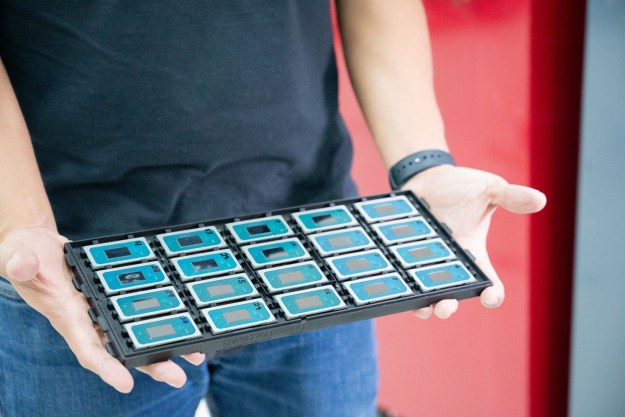On the heels of Intel’s official reveal for its 12th-gen Alder Lake-HX mobile chips, someone actually posted an early review of the Core i7-12800HX. We even got photos of the CPU itself, though the early performance results don’t show a big leap forward.
This leak comes courtesy of the Golden Pig Upgrade Pack team on a Chinese social media website. The testing was done on Lenovo Legion Y9000 with identical specs (other than the CPU of course).

One laptop had the Core i7-12700H (14-core) and the other had the Core i7-12800HX (16-core). Both laptops include 16GB of DDR5-4800 RAM and an Nvidia GeForce RTX 3070 Ti.
We get a glimpse of the 55-watt HX chip along with the RTX 3070 Ti chip inside of the laptop. The HX is notable for being a large chip, nearly as big as the desktop Alder Lake chips.
There were a number of benchmarks shown comparing the CPUs to each other. Those hoping for a major performance increase with the HX variant will likely be disappointed as the 12800HX is only marginally faster than the 12700H in some tests. Both productivity and gaming benchmarks yielded similar or slightly higher performance.


Interestingly, the Core i9-12900HX was also benchmarked, though it wasn’t compared to the Core i7 chips. It was combined with an RTX 3080 Ti. Unsurprisingly, it’s a powerful chip achieving a score of 1927 (single-core) and 23019 (multi-core) on Cinebench R20.
The primary benefit of the HX chips is scalability. The HX has sixteen PCIe Gen5 lanes for the GPU and four lanes for the SSD. This means support for up to eight SATA 3.0 connections, 14 USB 2.0 and 10 USB 3.0 connections, with two discrete Thunderbolt controllers.
Golden Pig Upgrade noted that because the power consumption is higher in the HX, only flagship laptops will likely include these CPUs due to the cooling requirements. Intel announced a number of upcoming
Golden Pig ultimately concludes that the HX is worth it depending on pricing:
“In the end, it is naturally the price. With so much foreshadowing, it is inevitable that the HX55 will be expensive. Even if the core price difference is not considered, the cost of power supply and heat dissipation of HX55 is significantly higher than that of H45. Basically, the price of the i7-12800HX is 1000 yuan more expensive than the i7-12700H of the same mold. It seems very low. If there are manufacturers who can make 500 yuan, I think it is still worth the extra money.”
It seems that the HX chips will be a huge bump in performance compared to the previous generation, but not a huge deal compared to the regular H models. That said, this is a super early review and we’ll have to do our own testing to see if the HX chips merit your money.
Editors' Recommendations
- Some Intel CPUs lost 9% of their performance almost overnight
- Do CPUs require drivers?
- How Intel and Microsoft are teaming up to take on Apple
- Nice try, Intel, but AMD 3D V-Cache chips still win
- Everything we know about Lunar Lake, Intel’s big next-generation chips




